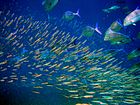滤食性动物

滤食性动物泛指任何通过过滤悬浮在水中的有机物质、食物颗粒和其它小型生物(微生物和浮游生物)来获取营养的水生动物,分为固着滤食、浮游滤食和游泳滤食三类。通常这些动物会吞下或接触水流,再通过特化的过滤器官将水中较大的物体阻挡,然后将筛滤过的水排出,被留下的物体被纤毛或黏液截住后教给身体进行消化。
滤食性动物在生态系统中占据基层消费者(初级或二级)的生态位,可以通过不断摄取生物质移除水体中多余的养分(如各种氮化合物和磷酸盐),在澄清水质方面发挥重要作用,因此被称为是“生态系统工程师”。现生的滤食物种跨越多个不同的门,包括多孔动物(海绵)、刺胞动物(水母、海笔和珊瑚)、节肢动物(磷虾、糠虾和藤壶)、软体动物(主要是双壳类,如蛤蜊、扇贝和牡蛎)、棘皮动物(海百合)、脊索动物(文昌鱼、海鞘和樽海鞘)以及包括绝大多数饲料鱼、鲢鳙、匙吻鲟、须鲸、蝠鲼和三种鲨鱼(鲸鲨、姥鲨和巨口鲨)在内的脊椎动物。一些鸟类(比如火烈鸟和几种鸭科水鸟)虽然是主要生活在近岸的陆生动物,但在水中觅食时也会采用滤食策略[1]。
鱼类
[编辑]甲壳动物
[编辑]
须鲸
[编辑]
双壳纲
[编辑]海绵
[编辑]
海绵没有真正的循环系统;相反,它们会产生用于循环的水流。 溶解的气体被带到细胞并通过简单的扩散作用进入细胞。代谢废物也透过扩散转移到水中。 海绵泵出大量的水。 例如,臼海绵是一种小的类白细胞海绵,高约10公分,直径约1公分。 据估计,水以每分钟6公分的速度通过80,000多条河道流入。 然而,由于臼海绵有超过200万个带鞭毛的腔室,其总直径比运河的直径大得多,因此通过腔室的水流速度减慢至每小时3.6公分。 这样的流速可以让衣领细胞轻松捕获食物。 水以约8.5公分/秒的速度通过单个排水孔排出:喷射力能够将废物带离海绵一定距离。
刺胞动物门
[编辑]翼龙目
[编辑]
传统上,真梳颌翼龙类的物种由于牠们数量多且细长的牙齿,倾向认为均属于滤食性动物,然而,目前仅有南翼龙属被确认属于滤食性,牠们具有鬃毛状的齿梳及向上弯的喙部,与现存的红鹤类似。其他真梳颌翼龙类物种则缺乏这样的特征,牠们的觅食行为反倒较接近现存的琵鹭,特化的牙齿是为了增加于水中扫动时的面积。而且,其他真梳颌翼龙类牙齿的特化程度明显不如南翼龙近似于鲸须的细齿[2]。
北方翼龙科被认为具有初阶的滤食性,透过牠们细长的牙齿在扫过水面时捕抓小型鱼类,不过牠们的牙齿并不如南翼龙那样的细小密集。总体来说,牠们的觅食行为更近似于现今的恒河豚属[2][3]。
海生爬行动物
[编辑]

鲜少有中生代海生爬行动物发展出滤食性的行为,在当时大多数的滤食性动物多半为厚茎鱼目的鱼类。然而,仍有部分蜥形纲物种演化成为滤食性动物。
例如,属于楯齿龙类的无齿龙属上颌前端具有一排细密的梳状齿以及类似红鹤的舌骨及颚部肌肉系统,再加上牠们的化石发现于湖泊沉积物内,推测无齿龙属与现存的红鹤可能占据了类似的生态位[4][5]。但更近年的研究认为,牠们可能其实是植食性动物,透过喙状嘴去刮取并过滤沉积物中的小型植物组织以及藻类[6]。
属于鳄形超目的腔鳄科主要生存于淡水环境,具有类似须鲸的颚部以及细小的牙齿。而生存于新生代的莫拉鳄属也有类似的特征,但两者的亲缘关系并不亲近,两者的口鼻部是各别演化出的特征[7][8]。
湖北鳄目为生存于三叠纪的爬行动物,采类似现存露脊鲸的瓢滤型滤食[9]。
部分蛇颈龙目物种,例如生存于白垩纪马斯特里赫特期薄板龙科的莫特纳龙,也属于滤食性[10]。莫特纳龙下颚的牙齿向下外翻,让牠们得以挖起海底的沉积物,并透过这些牙齿过滤,捕捉潜藏于其中的端足类及其他小型动物,如同现代的灰鲸[11]。
参考文献
[编辑]- ^ (英)大卫·伯尼著;金紫翎译;文星审译 北京:科学普及出版社 2013 第82页. 《动物生存秘籍》.
- ^ 2.0 2.1 Wilton, Mark P. Pterosaurs: Natural History, Evolution, Anatomy. Princeton University Press. 2013. ISBN 978-0691150611.
- ^ Pilleri G., Marcuzzi G., Pilleri O. Speciation in the Platanistoidea, systematic, zoogeographical and ecological observations on recent species. Investigations on Cetacea. 1982, 14: 15–46.
- ^ Rieppel, O. (2002). Feeding mechanisms in Triassic stem-group sauropterygians: the anatomy of a successful invasion of Mesozoic seas Zoological Journal of the Linnean Society, 135, 33-63
- ^ Naish D. Fossils explained 48. Placodonts. Geology Today. 2004, 20 (4): 153–158. S2CID 128475420. doi:10.1111/j.1365-2451.2004.00470.x.
- ^ Chun, Li; Rieppel, Olivier; Long, Cheng; Fraser, Nicholas C. The earliest herbivorous marine reptile and its remarkable jaw apparatus. Science Advances. May 2016, 2 (5): e1501659. Bibcode:2016SciA....2E1659C. PMC 4928886
 . PMID 27386529. doi:10.1126/sciadv.1501659.
. PMID 27386529. doi:10.1126/sciadv.1501659.
- ^ Langston, W. Mourasuchus Price, Nettosuchus Langston, and the family Nettosuchidae (Reptilia: Crocodilia). Copeia. 1966, 1966 (4): 882–885. doi:10.2307/1441424.
- ^ Aguilera, O. A.; Riff, D.; and Bocquentin-Villanueva, J. A new giant Purussaurus (Crocodyliformes, Alligatoridae) from the Upper Miocene Urumaco Formation, Venezuela. Journal of Systematic Palaeontology. 2006, 4: 221–232.
- ^ Sanderson S. L., Wassersug R. Suspension-feeding vertebrates. Scientific American. 1990, 262 (3): 96–101. Bibcode:1990SciAm.262c..96S. doi:10.1038/scientificamerican0390-96.
- ^ Plesiosaur Machinations XI: Imitation Crab Meat Conveyor Belt and the Filter Feeding Plesiosaur. 25 July 2015 [11 June 2018]. (原始内容存档于2016-12-26).
- ^ O'Keefe, F. R.; Otero, R. A.; Soto-Acuña, S.; O'Gorman, J. P.; Godfrey, S. J.; Chatterjee, S. Cranial anatomy of Morturneria seymourensis from Antarctica, and the evolution of filter feeding in plesiosaurs of the Austral Late Cretaceous. Journal of Vertebrate Paleontology. 2017, 37 (4): e1347570. S2CID 91144814. doi:10.1080/02724634.2017.1347570.
外部链接
[编辑]
| |||||||||||||||||||||||||||||||||
| |||||||||||||||||||||||||||||||||||||||||||||||
Text is available under the CC BY-SA 4.0 license; additional terms may apply.
Images, videos and audio are available under their respective licenses.


